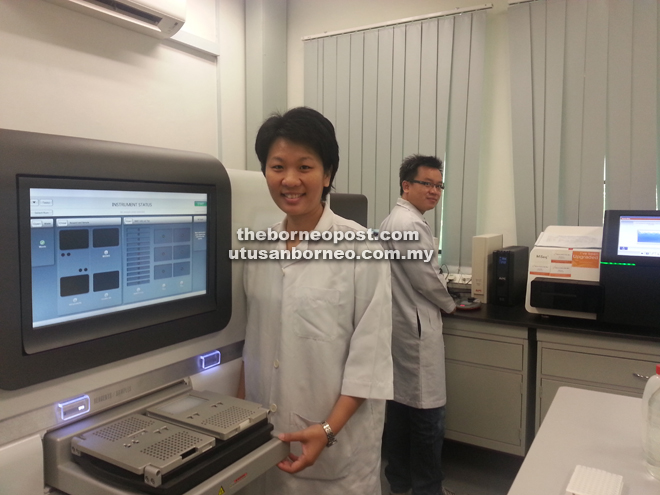
Students working with the PacBio and MiSeq Sequencers used in the study.
KOTA KINABALU: Researchers from Universiti Malaysia Sabah’s (UMS) Biotechnology Research Institute (BRI) have succeeded in cracking the genetic code of both the internationally renowned MD-2 Pineapple and the local Babagon variety.
The finding was reported this week in the early online issue of the Quartile 1 (Q1) periodical DNA Research, a publication of the Oxford University Press.
The team spent three years piecing together bit by bit the almost 526 million nucleotides that make up the pineapple DNA.
“The genome is difficult to unravel due to its high level of duplication and complexity,” said Associate Professor Dr Vijay Kumar, who is the lead principal investigator of the project. He added that the pineapple genome is bigger than rice by more than 100 million DNA bases.
Fruits are divided into two categories based on its ripening mechanism. It is widely understood that an increase in cellular respiration and a burst of ethylene prior to ripening, as in the case of banana, mango, tomato and papaya, is needed to trigger fruit ripening. These fruits are categorised as climacterics.
Meanwhile, the non-climacteric fruits such as pineapple, grapes and strawberries do not produce this response prior or during ripening.
Researchers have been puzzled by the role of ethylene in non-climacteric fruits for many years now. Using the completed pineapple genome as a reference, UMS researchers have found significant regulation of a protein which is involved in the biosynthesis of ethylene during fruit ripening in pineapples. This protein was completely missed prior to the availability of the genome due to the protein’s low expression in the fruit. The finding of the involvement of the protein in the ripening of pineapple fruit is very significant as it was previously thought that the hormone does not play a crucial role in the process. It highlights the importance of a reference genome in understanding biological processes leading towards the genetic improvement of the crop, said Raimi Redwan, a PhD student and first author of the manuscript.
Malaysia used to be a leading exporter of pineapples in the 1960s. However, the fruit has taken a backseat resulting in a marked drop in export revenues. Today, our neighbours, particularly Thailand and Philippines, are both leading pineapple producers in the world. In order to increase competitiveness, Malaysia, as with many other countries, has started to plant the highly popular MD-2 variety. The MD-2 is currently the leading commercial pineapple variety globally due to its superiority in colour, sweetness, flavour and uniformity of size.
“In order to improve existing traits and develop new ones, information regarding the genetic make-up is crucial. The current practice of solely depending on one cultivar for the entire production will have negative implication in the long run. Malaysia has to develop new varieties,” said Dr Kumar.
The completion of the pineapple genome will spearhead this effort, he added.
“It is interesting to note that the project is led by local researchers and completely done in Malaysia, showcasing that we do have the infrastructure and the bioinformatics capability to undertake such a complex task as this,” said Akzam Saidin, Senior Bioinformatics Scientist at Novocraft Technologies Sdn Bhd, who is a co-author of the paper.
“The DNA sequencing technology at UMS is impressive,” he added.
Novocraft Technologies, a Malaysian-based bioinformatics company, has worked closely with UMS in providing training and bioinformatics support for this project.
“We would like to congratulate the UMS team on their success,” said Colin Hercus, Novocraft Technologies’ Managing Director.
“On our part, we have developed the novoLRTM package to assist in genome assembly using hybrid technology. Using in-house algorithms, this software package uses Illumina short sequence reads combined with Pacific Biosciences long reads to enable accurate de novo assembly of genomes. The UMS team has efficiently utilised the technology and we are proud to have contributed,” added Colin.
Explaining further, “We have used state-of-the art PacBio’s and Illumina’s DNA sequencers to unravel the pineapple genome with 99% accuracy. We then performed many additional tests to validate the results,” said Raimi Redwan.
The team has identified more than 27,000 genes that code for the various traits we see in pineapples. These include, increase in sugar content, aroma, resistance to plant diseases, early flowering, and fruit development among others.
“We also found that the 45% of the pineapple genome contains repetitive elements with no known function, and previously known as junk DNA. In terms of its evolution, we found that there was a strong contraction of genes compared to other plants,” said Raimi.
Dr Kumar explained that this indicated that over the years the pineapple genome has accumulated many mutations that results in a loss of function. This can be clearly seen when a comparison was made between the two pineapple varieties sequenced. The Babagon pineapple shows significant variance in genes related to plant immunity and defence, subjecting it to a higher level of susceptibility to diseases and injury.
The completion of the genomes comes in the wake of another seminal publication of the pineapple’s chloroplast by the team last August 2015, reported in BMC Plant Biology, a Q1 journal in plant sciences.
Dr Zarina Amin, deputy director of BRI, is excited about the group’s recent findings.
“With the completion of the genome, it is now possible to further improve the agronomic traits of the crop. This puts UMS in the forefront of pineapple genetics and breeding,” she said.
